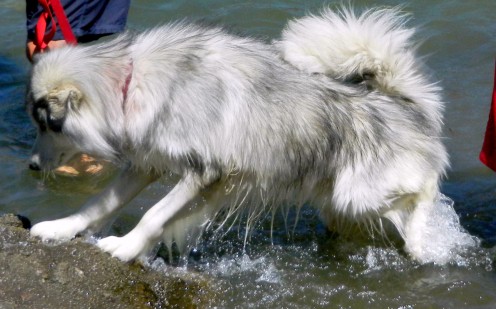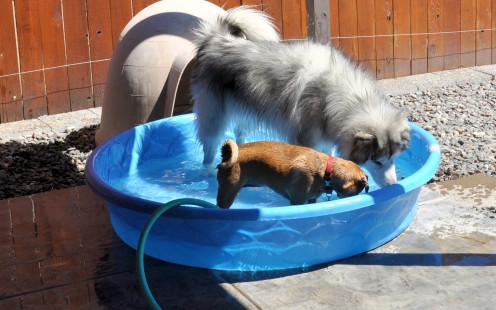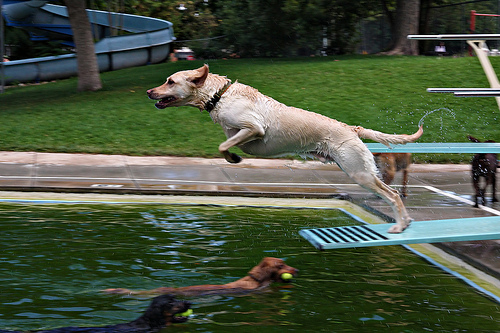How To Teach Your Dog To Swim
HOW TO TEACH YOUR DOG TO SWIM
After having my latest 'adventure' at the lake with Griffin the Malamute, I decided that I needed to step back and figure out what we could improve upon in terms of how to teach my dog to swim.
On doing some research on the subject, I think we did some good things, but then we could have done some better things. Stay tuned and read more about how to teach your dog to swim!
TIPS ON HOW TO TEACH YOUR DOG TO SWIM
Contrary to popular opinion, all dogs are not natural born swimmers! Molly, the puggle shown in the photos with Griffin is a 'natural' but even she learned the ropes so to speak carefully and repeatedly to become the Olympic swimmer that she now is!
Griffin was totally speechless when he saw her in action. Unfortunately, I think that Griffin got off to a rather shaky start and we will have to revisit swimming 101 with the following knowledge now under our belts!








How To Teach Your Dog To Swim
THE WAY TO TEACH YOUR DOG TO SWIM
- Teaching your dog to swim is really no different whether you teach them in the ocean, a pool, a lake or a river - the concepts are pretty much the same.
- It is wise (as my daughter reminded me) to use a life jacket at first - especially if the dog is showing fear of the water or the state of having its paws leave 'earth'. There are various and sundry brands available in all sizes! (see below)
- Make sure your dog can touch bottom at first - this would definitely not be a good time to 'sink or swim' and throw your dog into the water! Many dogs (as you can see) panic when their feet start to leave ground (or rocks in this case).
- Try to start out in a shallow area as Bob is demonstrating and walk the dog back and forth, back and forth so that they can get the 'feel' of the water and how it is moving around them, the different textures of the bottom, etc.
- It may take a while before a dog is actually comfortable paddling and the walk-about may have to occur many times in the water first.
- It is better for the dog to actually make the decision to walk out further to become buoyant rather than being pushed, shoved, or dragged to such a state. If you do that, they will remember and probably develop a fear of the water.
- Use a treat as a lure if the dog does not seem to want to venture out further in the water. Some dogs also will swim out after a squeaking toy or ball - or a tennis ball. (Malamutes are not known for their retrieving side so this would not work - at least not in water)
- Stay beside the new swimmer as you guide him or her into deeper water - and put a hand beneath the belly or at the base of the tail. It can give a bit of reassurance that you are there and nothing bad will happen. Of course in Griffin's case, once his legs pumped a couple of times, he was in an upright position or running for all he was worth so this may take some time!
- Do not let your dog drink from pools, rivers, lakes, oceans, etc. If you do, this encourages them to drink any time that they are in water and that is not good!
- If you have had your dog out for a long period of time in the water, watch for signs of fatigue such as wheezing, pale or purple gums, shivering, etc. It is best to do less multiple times than to do too much at one time.
- Super important point to make - a dog should not do heavy exercise or exertion (such as swimming) 1-1/2 to 2 hours after eating or before eating because doing so puts your dog at high risk for developing bloat, which can be deadly. So good rule of thumb - no exercise several hours before or after swimming!







Photo Credit: WikiCommons GeographBot
More on How to Teach Your Dog to Swim
One very effective way to introduce your dog to water is to have a small pool available. If you have any sort of pool available for your dog though that is deeper than the dog is high, you should be with the dog AT ALL TIMES. Dogs can drown just like people and should always be supervised. If you have a very large pool, just like for children, make sure the pool has an alarm to designate someone going into the pool, canine or human!
Likewise, never let a dog swim out in a river, an ocean or a lake unless you are 100% positive that the dog can handle it without a life jacket. Life jackets for dogs do save lives and again, dogs can drown just as easily as people so would err on the side of caution and make sure the dog is protected.
We bought Griffin the largest size plastic kiddie pool this year (last year he had a smaller one but no longer fit in it this year!) and set it up as soon as the temperatures started to soar. He actually loves the water - in his little safe pool - and will happily go down there when he gets too hot and get in all by himself and splash about. He usually takes his toys in as well and throws them around and plays in the water.
Having a wading pool is a great way to teach a dog that water is 'safe' and also is great for keeping them cool on hot, hot days. As you can see from the pictures, he and Molly had a good time playing poolside in our backyard the day or so before we went to the lake although that was not enough of a prerequisite to make him feel at ease in a big lake!
If you have a pool that is large and your dog needs to climb up to get in, have a safe set of stairs that a DOG can climb for the dog to feel confident. Some ladders or ramps are made specifically for access by dogs and are great ways for the dog to build confidence on entering and exiting the pool. Again, never force, push, or pull a dog into swimming situations - it is far better that they decide on their own that it is a good thing!
Once a dog has mastered swimming basics and feels confident about the water, that is the time to remove life jackets or advance water sport - like diving off diving boards or fetching toys in the water, etc.
Some towns actually have pools that are designed only for dogs - amazing! However, it can be a little pricey sometimes - one Manhattan Tribeca dog pool charges $50-65 for a 1/2 hour of dog swim! It is called Water 4 Dogs and boasts an 8000 gallon pool kept at a balmy 92 degrees!
REASONS TO TEACH YOUR DOG TO SWIM
- Pure fun!
- Overweight - just like people, if a dog is overweight and needs to exercise and lose weight, this is a great way for a dog to drop pounds and inches!
- Rehab after an injury. Much like people, if a dog has been injured and is having trouble with mobility, swimming is a great form of exercise that is almost totally painless.
- Hip or joint replacement. We had a black lab who had grade IV hip dysplasia. She had a hip replacement and had a very prolonged recovery time - 4 months required for no weight bearing. When she was allowed to weight bear on the leg, I took her to the local lake and had her swim every day for exercise. Swimming after joint surgery is the recommended canine exercise (human as well).
- Ligament repair. Same thing - we had a dog who tore a ligament in his knee running and swimming was the recommended form of exercise. Too bad he hated the water so it was not very effective!
- Arthritis. This is a low impact form of exercise that helps dogs with arthritis regain mobility and decreases pain.
- If a dog has had a stroke and has impaired motor function, swimming is extremely therapeutic and again, low impact - an excellent way to rehab - just like with humans!
- General aerobic exercise - if you have a high energy pet with no way to exercise, swimming is a great way to get in exercise and keep the dog fit at the same time. It is great cardiovascular exercise just like for humans.


Photo Credit: Flickr AMagill
Photo Credit: Flickr PMarkham
Once Your Dog Has Learned to Swim
Once your dog has mastered the fine art of swimming, there are all kinds of possibilities!
I regularly see folks floating on the Deschutes River near where we live with their dogs (usually in life jackets) paddling alongside in the water while they river raft. I've also seen folks paddle surfing while their dogs swim along.
You can teach your dog to jump off diving boards or do water tricks.
You can also provide your dog with a snood which is a garment that fits over the dog's head and neck and prevents water from going into their ears - sometimes a problem as in the case of my black lab and her very long ears!
Remember to always rinse your dog with warm water after a swim - no need to shampoo but rinsing is recommended due to chlorine, salt water, lake water, etc. so as to not create bacterial growth or dryness of the skin.
Summing It Up
Teaching your dog to swim is a great thing to do as it is a wonderful form of exercise for a dog.
Teaching them to be unafraid is the most important part of swimming. I think I had forgotten this important fact when I tried to coax Griffin into the water a week ago. I assumed that because he played in his wading pool, he would be a natural at the lake. Alas, I forgot that it was a totally different terrain, a moving one at that, and that he needed a slow, steady introduction to this new experience rather than a quick dip.
Start out slow as I plan to do on the redo - work up to a level that you and your dog feel comfortable with.
As in any other endeavor with your dog, have a good time at it and enjoy the time that you have together with your good friend! Praise, praise, praise and within no time, he or she will be swimming like Mark Spitz!
Note: The second video I disagree with the fellow being out of the water but get his theory I guess on getting the dog to swim at first! I especially liked this video though because it addresses the dangers of dogs drowning in pools.











